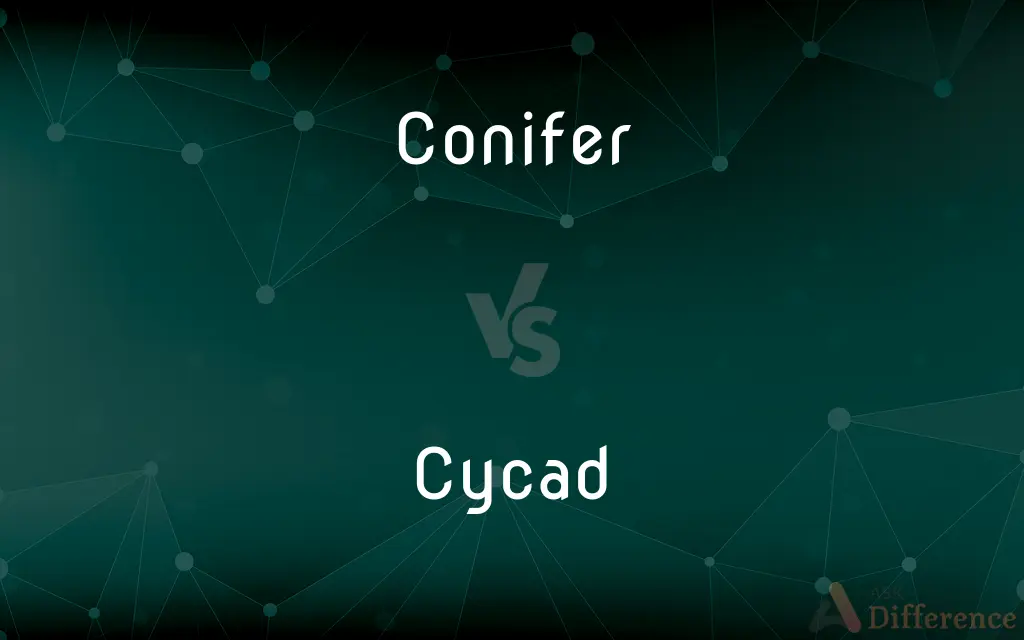Conifer vs. Cycad — What's the Difference?
By Fiza Rafique & Urooj Arif — Updated on March 31, 2024
Conifers are a diverse group of gymnosperm plants known for their needle-like leaves and production of cones, while cycads are ancient gymnosperms with a palm-like appearance and produce seeds in large cones.

Difference Between Conifer and Cycad
Table of Contents
ADVERTISEMENT
Key Differences
Conifers, belonging to the division Pinophyta, are predominantly evergreen trees or shrubs characterized by their needle-like or scale-like leaves and the production of cones which contain their seeds. They are adapted to a wide range of climates and can be found in various parts of the world, from cold northern forests to warm temperate regions. Cycads, on the other hand, are part of the division Cycadophyta and are known for their stout, woody trunks and large, compound leaves that give them a superficial resemblance to palms or ferns, despite being more closely related to conifers and other gymnosperms.
While conifers are noted for their ecological and economic importance, providing significant lumber resources, cycads are often prized for their ornamental value. Cycads have a slower growth rate and are considered living fossils, having changed little since the Jurassic period. Conifers, however, exhibit a faster growth rate and have adapted over millions of years to become dominant forest trees in many parts of the world.
Conifers reproduce through the formation of male and female cones, with some species having both types on the same plant and others on separate plants. Pollination occurs via wind, facilitating the spread of their seeds. Cycads, however, reproduce using large, often brightly colored cones, and pollination is frequently facilitated by specific insects, showcasing a more specialized reproduction strategy.
In terms of conservation, many cycad species are under threat due to habitat loss, over-collecting, and climate change, making them one of the most endangered plant groups in the world. Conifers also face threats from deforestation and climate change, but their widespread distribution and diversity afford them a better chance of survival compared to cycads.
Despite their differences, both conifers and cycads share the characteristic of being gymnosperms, meaning they produce seeds without the enclosure of an ovary. This places them outside the angiosperm category and highlights their ancient lineage among seed-producing plants.
ADVERTISEMENT
Comparison Chart
Classification
Division Pinophyta
Division Cycadophyta
Appearance
Needle-like or scale-like leaves, cone-bearing
Stout trunks, large compound leaves
Habitat
Wide range, from cold to temperate regions
Primarily tropical and subtropical
Growth Rate
Generally faster
Slower
Reproduction
Wind pollination, male and female cones
Often insect pollinated, large cones
Economic Use
Lumber, paper, ornamental
Mainly ornamental
Conservation
Varied, some species at risk
Many species critically endangered
Compare with Definitions
Conifer
Produces cones for seed dispersal.
The fir tree's cones stand upright on its branches.
Cycad
Have large, compound leaves that resemble those of palms.
The sago palm, a type of cycad, features feather-like leaves.
Conifer
Adapt to a broad range of climates.
Conifers dominate the boreal forests of the northern hemisphere.
Cycad
Grow in tropical and subtropical environments.
Cycads thrive in the warm climates of Florida and Hawaii.
Conifer
Mostly needle-like, designed to conserve water.
The spruce tree has sharp, evergreen needles.
Cycad
Use cones for reproduction, often pollinated by insects.
The female cycad cone can be quite large and colorful.
Conifer
A large group of gymnosperm plants known for needles and cones.
The pine is a type of conifer that's crucial for the lumber industry.
Cycad
Ancient plants with a palm-like appearance and large cones.
Cycads are often used in landscaping for their distinctive look.
Conifer
Provide wood, paper, and resins.
Many conifers are harvested for their valuable timber.
Cycad
Many species are endangered.
The cycad is considered a living fossil, with some species facing extinction.
Conifer
Conifers are a group of cone-bearing seed plants, a subset of gymnosperms. Scientifically, they make up the division Pinophyta (), also known as Coniferophyta () or Coniferae.
Cycad
For the insect, see Cicada.Cycads are seed plants with a very long fossil history that were formerly more abundant and more diverse than they are today. They typically have a stout and woody (ligneous) trunk with a crown of large, hard and stiff, evergreen leaves.
Conifer
Any of various mostly needle-leaved or scale-leaved, chiefly evergreen, cone-bearing gymnospermous trees or shrubs of the order Coniferales, such as pines, spruces, and firs.
Cycad
Any of various gymnospermous cone-bearing evergreen plants of the division Cycadophyta, native to warm regions and having large pinnately compound leaves.
Conifer
(botany) A plant belonging to the order Coniferales; a cone-bearing seed plant with vascular tissue, usually a tree.
Cycad
(botany) Any plant of the division Cycadophyta, having a stout and woody trunk with a crown of large, hard and stiff, evergreen leaves.
Conifer
A tree or shrub bearing cones; one of the order Coniferae, which includes the pine, cypress, and (according to some) the yew.
Cycad
Any plant of the natural order Cycadaceæ, as the sago palm, etc.
Conifer
Any gymnospermous tree or shrub bearing cones
Cycad
Any tropical gymnosperm of the order Cycadales; having unbranched stems with a crown of fernlike leaves
Common Curiosities
What are the main differences between conifers and cycads?
The main differences lie in their appearance, habitat, growth rate, reproduction methods, and uses, with conifers being widely used for lumber and cycads valued for ornamental purposes.
Are all conifers evergreen?
Most conifers are evergreen, but there are exceptions, such as the larch, which is deciduous.
Can cycads survive in cold climates?
Cycads are best suited to tropical and subtropical climates and generally do not tolerate cold conditions well.
Why are cycads considered living fossils?
Cycads are called living fossils because they have existed for millions of years and their appearance has changed very little since the time of the dinosaurs.
How do cycads reproduce?
Cycads reproduce using large cones, and many species rely on specific insects for pollination.
Are conifers important for the environment?
Yes, conifers play a crucial role in their ecosystems, providing habitat and food for wildlife, as well as contributing to the global carbon cycle.
Why are cycads not as common as conifers?
Cycads have a slower growth rate and are less adaptable to varied climates compared to conifers, making them less common in natural settings.
What are some conservation efforts for cycads?
Conservation efforts include habitat protection, regulated trade, and the cultivation of cycads in botanical gardens and arboretums.
How can I tell a conifer from a cycad?
Conifers generally have needle-like leaves and produce wood cones, while cycads have palm-like, compound leaves and large, sometimes colorful cones.
How do conifers adapt to cold climates?
Conifers have several adaptations for cold climates, including needle-like leaves to reduce water loss and conical shapes to shed snow.
Are there any edible conifers or cycads?
Some conifer parts, like pine nuts, are edible. However, many cycads contain toxins and are not edible without proper processing.
Can conifers grow in tropical climates?
Some conifer species can adapt to warmer, tropical climates, but they are more commonly associated with temperate and cold regions.
How long can cycads live?
Cycads can live for several decades, with some specimens known to be over a century old.
Is it legal to own a cycad?
While it's legal to own cycads, their sale and trade are strictly regulated to prevent illegal poaching and ensure conservation.
Share Your Discovery

Previous Comparison
Port vs. Portal
Next Comparison
Integer vs. NumberAuthor Spotlight
Written by
Fiza RafiqueFiza Rafique is a skilled content writer at AskDifference.com, where she meticulously refines and enhances written pieces. Drawing from her vast editorial expertise, Fiza ensures clarity, accuracy, and precision in every article. Passionate about language, she continually seeks to elevate the quality of content for readers worldwide.
Co-written by
Urooj ArifUrooj is a skilled content writer at Ask Difference, known for her exceptional ability to simplify complex topics into engaging and informative content. With a passion for research and a flair for clear, concise writing, she consistently delivers articles that resonate with our diverse audience.
















































